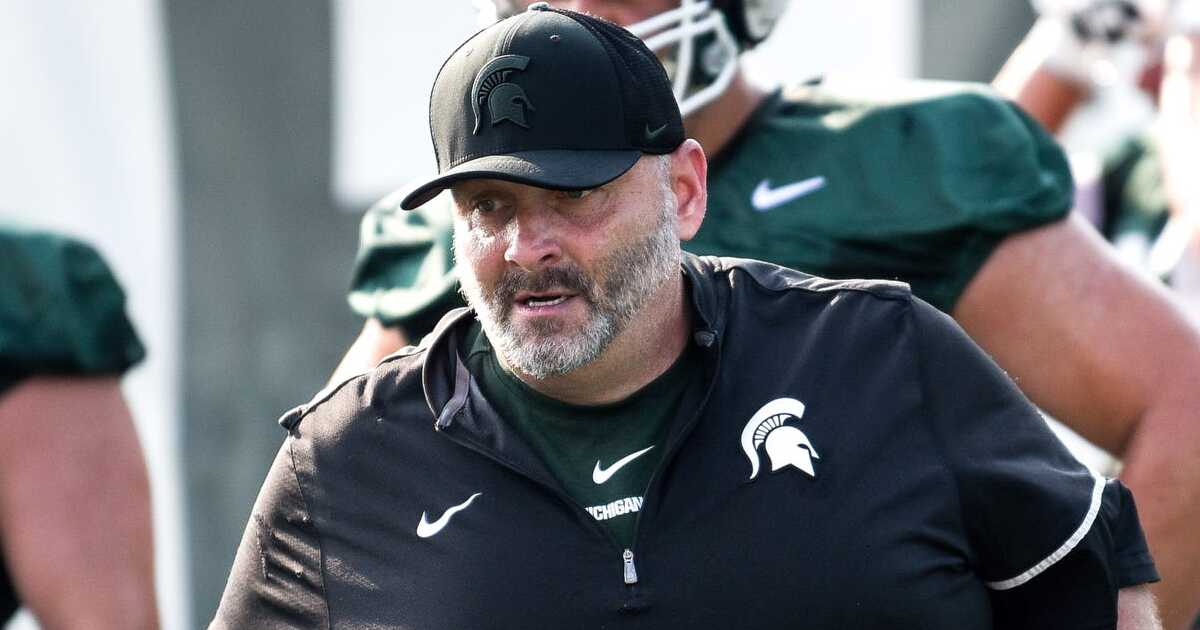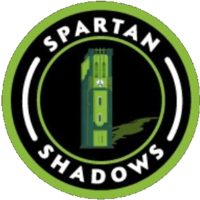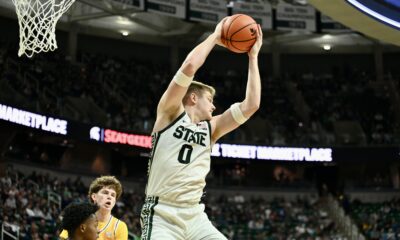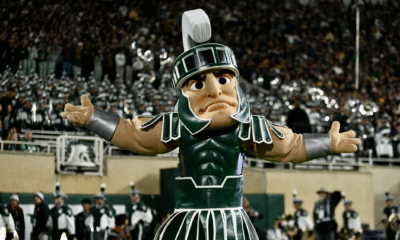Michigan State football has been Chris Kapilovic’s home since 2020. How has the Kapilovic era played out so far?
Michigan State football has been the sixth stop in the 30-plus year career of Chris Kapilovic, the current offensive line coach, run game coordinator, and assistant head coach for the Spartans.
This fall will be his fourth year in East Lansing, albeit only the third relatively normal one. Earlier in the week, fellow colleague, Owen Schuchaskie, touched on the reason for optimism for the offensive line unit in 2023. My aim here is to review the offensive lines that were during the Mel Tucker era, and in turn provide some reasonable expectations for the Juice Squad in 2023.
Returning production vs. lost production is always a vast topic of conversation for not only position groups, but for entire rosters as well.
Below is a quick guide to how the snap production varied between returning and outgoing players from 2020-2022. For reference, snaps lost in 2020 are from 2019 production numbers.
-
- 2020 (finished 2-5)
- Returning: 3409
- Lost: 1392
- 2021 (finished 11-2)
- 2022 (finished 5-7)
- Returning: 1686
- Lost: 2911
The Michigan State offensive line losing just two offensive snaps coming into the 2021 season is just objectively hilarious. I had to check this about six times. Even with a COVID-reduced season in terms of production numbers, that’s still returning 99.92% of your offensive line production.
Kenneth Walker III did do a lot to cover up some of the mistakes this line made in 2021, but returning this level of continuity is always a benefit to your roster. The 2022 offensive line pretty much was what we thought they were going to be, and that was uh… not great. This all started with not having enough offensive linemen available to even practice for portions of 2022 spring ball, and finished with MSU failing to get enough push on numerous third and fourth-and-shorts during the season that felt like it would never end.
There are a few stats I cling to when judging the overall health of an offensive line, all of which are provided by FootballOutsiders. Average line yards is a stat that gives 100 percent credit to the offensive line for rushes 0-3 yards, 50 percent credit for 4-8 yards, and zero credit for anything after eight yards. Michigan State has ranked 124th, 85th, and 104th over the past three seasons, with 2021 being the only season where the average line yards have been over 2.5 (2.57). For reference, the national champions have ranked 14th (2.99), 11th (3.06), and 20th (2.92).
It is imperative for the success of the pro-style offense that MSU runs for this 2023 offensive line to get this average yardage number not only above 2.5, but 2.75.
Power success rate is another stat that I look at. This is solely based on runs of third or fourth-and-2 or less that achieved a first down. Michigan State has been dreadful in this category, ranking 118th, 71st (thanks K9), and 118th again. If your power run game is sniffing a 50/50 chance of converting on average, that is not a good thing.
Alabama converted 90.3 percent of the time in 2020, good for fifth in the nation. In 2021, Georgia inexplicably managed to get away with a 72.4 percent success rate, good for 52nd, and falling even lower in 2022, ranking 71st at 67.7 percent, which was about what MSU’s success rate in 2021 was. Power run game is not always a team’s strength, but there is nothing more satisfying for an offense than seeing third-and-short and knowing the boys up front can get the push you need.
Stuff rate means what it sounds, as it is the percentage of runs where the running back is stuffed at or behind the line of scrimmage. Similar to the power success rate, I like this one because it’s a basic concept in offensive line play — can you block? For Michigan State, the answer has been “lol no,” “we’re not terrible at it,” and “this is harder than we thought.”
MSU was stuffed 26.2 percent of the time in 2020 (124th), 18.6 percent in 2021 (83rd), and 20 percent of the time in 2022 (103rd). Knowing the most positive outcome for one of every 4-5 runs is zero yards is less than ideal. It’s even less ideal when you learn that Alabama was stuffed 13.1 percent (12th) in 2020, and Georgia was only stuffed 11.7 percent (7th) in 2021 and 14.7 percent (25th) in 2022.
Finally, sack rate is the last stat I look at, as it’s always crucial to keep your quarterback clean and at least give him enough time to get the ball out to live another down if he has to. Thankfully, this is one thing that the offensive line has done a very good job of when you consider the rest of their body of work.
The offensive line has kept the sack rate under five percent 2-of-3 years, with Kapilovic’s first season in East Lansing being the lone year above five at 5.6 percent, which ranked 50th in the nation, which still put them in the top half of the nation. MSU ranked 28th (4.9 percent) and 20th (3.7 percent) in 2021 and 2022, respectfully. Although this doesn’t take into account the amount of quarterback hits or pressures, it’s still a positive that plays are at worst going for zero yards as opposed to losing 6-7. If MSU can keep this area of play up, they’re at least in striking distance with the big boys as Alabama ranked seventh with 2.7 percent in 2020 and Georgia was 20th (4.6 percent) in 2021 and was at 1.4 percent in 2022.
Something that the numbers don’t quite illustrate is the level of young talent on this roster and, more importantly, Kapilovic’s recruited players to his and Tucker’s strict height and size requirements. That is the reason for optimism there.
Eight players who played at least one offensive snap in 2022 return to the offensive line in 2023, and four of those are a part of Kapilovic’s first class. Outside of Gavin Broscious, who appeared to suffer a significant knee injury in the spring, the four-man 2022 class looks to get in the rotation for playing time as well. All of these guys are fighting for snaps along with the newest Spartan offensive linemen in Cole Dellinger, Stanton Ramil, and Keyshawn Blackstock, arguably one of Michigan State’s strongest offensive line classes from a talent perspective in recent memory.
There are certainly pieces to work with in this offensive line.
Barring any transfers, this group returns 2,998 snaps, while losing 1,099 going into the fall. With Nick Samac and J.D. Duplain providing leadership and experience with this group there are definitely a few things I expect from this offensive line and if they can’t manage it, well it may be time to start having discussions.
At minimum, I want zero of the four rankings I listed above to be below the national average. If this team is going to be able to cobble together a competent offense, it has to start up front with the five being consistent and with competence comes consistency. Since 2018, teams that have won eight-plus games averaged 2.71 line yards, a power success rate of 72.30 percent, a stuff rate of 17.07 percent, and a sack rate of 5.84 percent. I think those numbers are more than doable with players that have been in the system and talent this room possesses.
There is a lot of anxiety surrounding this program, and its about that time for Coach Kap to show why USC wanted to poach him away from MSU.
You can read more of my bad takes in short form on twitter @maxwellklitzke
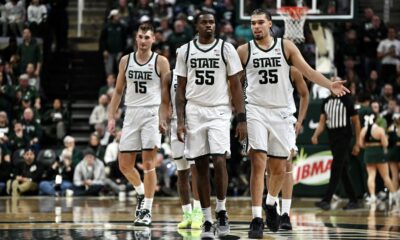
 BASKETBALL2 weeks ago
BASKETBALL2 weeks ago
 MORE SPORTS3 days ago
MORE SPORTS3 days ago
 BASKETBALL3 days ago
BASKETBALL3 days ago
 FOOTBALL3 days ago
FOOTBALL3 days ago
